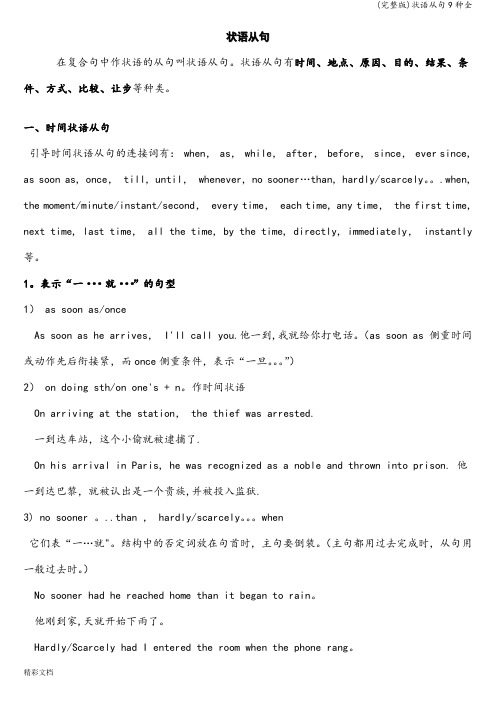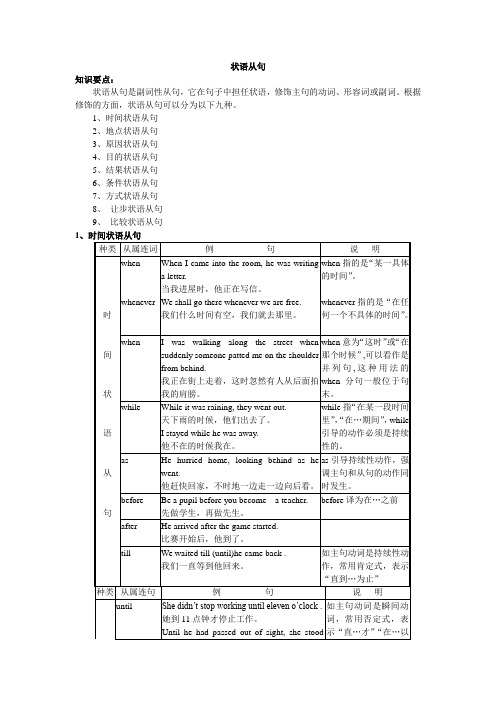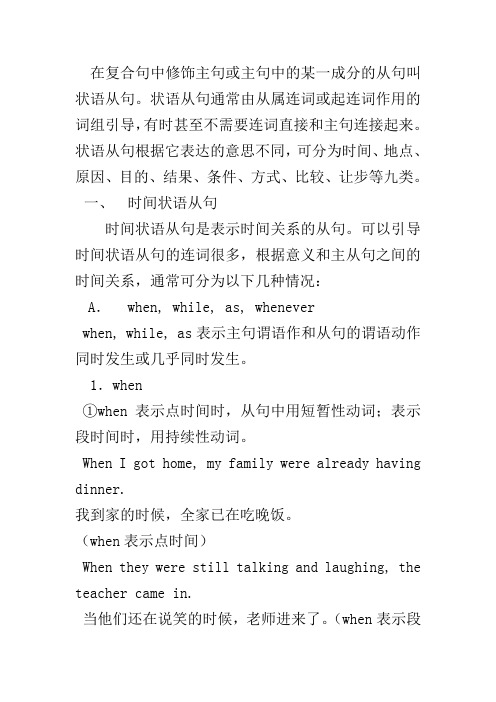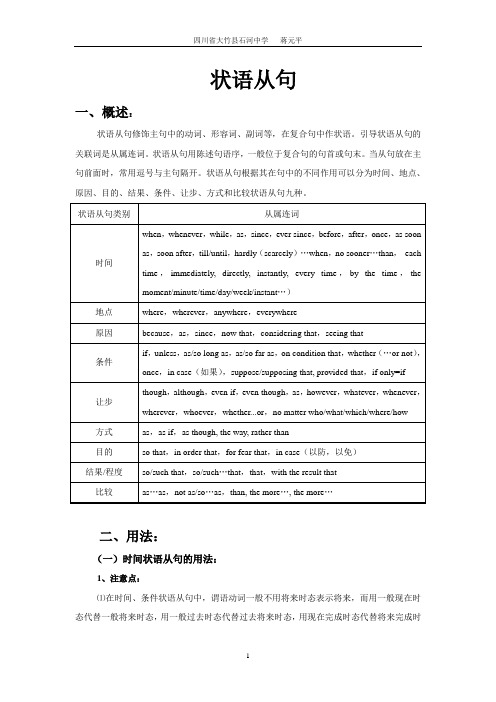(完整版)状语从句9种全.doc
(完整版)状语从句的讲解最全的状语从句讲解

状语从句的讲解就是用一句话作状语分为:时间,地点,方式,原因,结果,条件,让步,目的,比较一、时间状语从句第一次见到你一见到你我就喜欢上了你直到见到你五岁时见到你When, as, while, before, after, since, till/until, as soon as no sooner…than…scarcely…when…hardly…when… the minute the second the instant the moment by the time 截止 immediately instantly directlyeach time every time next time the first time on doing sthwhenwhile 当…时as1。
when 1)当…时/ 延续性动词短暂性动词都可用2)这时/3)届时、到时I was watching TV when my cellphone suddenly rang这时When I was five years old I could speak five languagesThe wet weather will continue tommorow when a cold front is expected to arrive届时到时注意:时间状语从句中动作发生有前后时先发生的用过去完成时When my mother came back I had already gone to bed.2。
while 1)从句动词延续性2)同时发生3)对比的意味“然而”4)趁着He taught himself while he worked in a bank 延续性动词当他在银行上班时While we were working they were having a rest.对比While they were having a discussion , they got very confused。
状语从句(9种

1.时间状语从句常用引导词:when, as, while, as soon as, before, after, since , till, until特殊引导词:the minute, the moment, the second, every time, the day,the instant, immediately , directly, no sooner … than, hardly …when, scarcely … whenI didn’t realize how special my mother was until I became an adult.While John was watching TV, his wife was cooking.The children ran away from the orchard(果园), the moment they saw the guard.No sooner had I arrived home ,then it began to rain.Every time I listen to your advice, I get into trouble.2.地点状语从句常用引导词:where特殊引导词:wherever, anywhere, everywhereGenerally, air will be heavily polluted where there are factories.Wherever you go, you should work hard.地点状语从句§4地点状语从句 (adverbial clause of place) 地点状语从句一般由连接副词where, wherever等引导,已经形成了固定的句型,例如:句型1:Where+地点从句,(there)+主句。
【注意】此句型通常译成“哪里……哪里就……”;主句在从句后面时,there可用可不用;如果主句在从句的前面时,一般都不用there。
(完整版)状语从句(完整归纳)

状语从句一.分类:种类连接词注意区别:时间状语when/whenever/while/as/before/after/instantly/until/till/by the time/as soon as/hardly…when/directly/no sooner…than/the moment/the minute/immediately有一些表示时间的名词短语也可用来引导时间状语从句:the minute, the moment, every time, the first time例:The moment he reached the country, he started hissearch. 他一到达这个国家,就开始他的探寻工作。
有一些表示时间的副词也可用来引导时间状语从句:directly例:Directly the master came in, everyone was quiet.校长一进来,大家就安静下来as和when、while:as, when 引导短暂性动作的动词。
当从句的动作发生于主句动作之前,只能用when 引导这个从句,不可用as或while。
从句表示"随时间推移"连词能用as,不用when 或while。
till/until和not…till/until:Until可用于句首,而till通常不用于句首。
地点状语where//wherever where,表示某一个;wherever,表示任何一个。
原因状语Because/as/since/now that/forbecause和since、for、as、now that:because语势最强,用来说明人所不知的原因,回答why提出的问题。
当原因是显而易见的或已为人们所知,就用as或since。
由because引导的从句如果放在句末,且前面有逗号,则可以用for来代替。
但如果不是说明直接原因,而是多种情况加以推断,就只能用for。
(完整版)状语从句9种全

状语从句在复合句中作状语的从句叫状语从句。
状语从句有时间、地点、原因、目的、结果、条件、方式、比较、让步等种类。
一、时间状语从句引导时间状语从句的连接词有: when, as, while, after, before, since, ever since, as soon as, once, till, until, whenever, no sooner…than, hardly/scarcely。
.when, the moment/minute/instant/second, every time, each time, any time, the first time, next time, last time, all the time, by the time, directly, immediately, instantly 等。
1。
表示“一···就···”的句型1) as soon as/onceAs soon as he arrives, I'll call you.他一到,我就给你打电话。
(as soon as 侧重时间或动作先后衔接紧,而once侧重条件,表示“一旦。
”)2) on doing sth/on one's + n。
作时间状语On arriving at the station, the thief was arrested.一到达车站,这个小偷就被逮捕了.On his arrival in Paris, he was recognized as a noble and thrown into prison. 他一到达巴黎,就被认出是一个贵族,并被投入监狱.3) no sooner 。
..than , hardly/scarcely。
when它们表“一…就"。
结构中的否定词放在句首时,主句要倒装。
(完整版)英语状语从句汇总整理版

英语中的九大状语从句状语从句在主从复合句中修饰主句中的动词、形容词或副词等,按意义可以分为时间、地点、原因、目的、结果、条件、方式、比较、让步等状语从句。
一.时间状语从句。
通常由从属连词when, whenever, as, while, before, after, as soon as, till, until, since, once (一旦), hardly……when…, no sooner…….than…; 等引导。
例如:The cyclist started just as the lights changed to green.Whenever we met with difficulties , they cam to help us.He didn’t leave his office until he had finished the day’s work.应注意的问题1.在时间状语从句中,通常要用动词的一般现在时态表示一般将来时态,用一般过去时态表示过去将来时态。
但when 引导一般疑问句或名词性从句时不受上述语法规则的限制,因此,应该加以区分。
例如:When China will enter WTO depends on the bilateral (双边的)joint efforts.Once you understand the rules of the game, you’ll enjoy it.2.when , while, as 的不同用法。
一般说来,当主、从句的动作是同时发生的事,三者可以换用。
when 既可以引导一个持续动作,也可以引导一个短暂动作,可用于主句和从句动作同时发生或从句动作先于主句动作;while 引导的动作必须是持续性的,强调主句和从句的动作同时发生,往往侧重主句和从句动作的对比;as 用于引导“在某行为的继续中发生某事”的“继续之行为”,所以多与过去进行时连用,翻译成“一边……一边……”或者表示动作的变化,翻译成“随着……”。
状语从句完整版

间
状
when
I was walking along the street when suddenly someone patted me on the shoulder from behind.
我正在街上走着,这时忽然有人从后面拍我的肩膀。
when意为“这时”或“在那个时候”,可以看作是并列句,这种用法的when分句一般位于句末。
万一我忘了,请提醒我一下。
So far as I know, the book will be published next month.
据我所知,那本书下月出版。
unless从句的谓语只能用肯定式。unless和if…not同义,unless是书面语,if…not是口语,通常二者可以换用。
条件状语从句中的谓语动词的时态一般要用现在时或过去时代替一般将来时或过去将来时。
他的行动就好象什么也没有发生。
They treat the black boy as if (though) he were an animal.
他们对待这黑孩子仿佛他是一头牲口。
此处as译为,按照或正如
as if或as though的意义和用法基本一样。从句中可以用现在时表示可能符合事实,也可以用虚拟语气。
It is so interesting a novel that all of us want to read it.
这是一本十分有意思的书,大家都想看。
such…that的such后面跟名词,如果名词是单数就要用such a /an…that还可以转换用so…that,语气较强
种类
从属连句
例句
说明
即使明天下雨,我也要去。
完整版英语语法状语从句的归纳总结

在复合句中修饰主句或主句中的某一成分的从句叫状语从句。
状语从句通常由从属连词或起连词作用的词组引导,有时甚至不需要连词直接和主句连接起来。
状语从句根据它表达的意思不同,可分为时间、地点、原因、目的、结果、条件、方式、比较、让步等九类。
一、时间状语从句时间状语从句是表示时间关系的从句。
可以引导时间状语从句的连词很多,根据意义和主从句之间的时间关系,通常可分为以下几种情况:A.when, while, as, wheneverwhen, while, as表示主句谓语作和从句的谓语动作同时发生或几乎同时发生。
1.when①when表示点时间时,从句中用短暂性动词;表示段时间时,用持续性动词。
When I got home, my family were already having dinner.我到家的时候,全家已在吃晚饭。
(when表示点时间)When they were still talking and laughing, the teacher came in.当他们还在说笑的时候,老师进来了。
(when表示段时间)He waved a hello when he saw her.当他看见她的时候,就挥手打了个招呼。
(when表示点时间)When you think you know nothing, you begin to know something.当你认为自己一无所知的时候,就开始知道一些事情了。
(when表示段时间)注意:当when意思是正当……时候(and at that moment)时,when只能跟在前一分句之后。
He was about to go to bed when the doorbel rang. 他正要上床,忽然门铃响了。
They were watching the World Cup when suddenly the lights went out.他们正看着世界杯比赛,突然灯灭了。
状语从句(高考复习完整版)

状语从句一、概述:状语从句修饰主句中的动词、形容词、副词等,在复合句中作状语。
引导状语从句的关联词是从属连词。
状语从句用陈述句语序,一般位于复合句的句首或句末。
当从句放在主句前面时,常用逗号与主句隔开。
状语从句根据其在句中的不同作用可以分为时间、地点、原因、目的、结果、条件、让步、方式和比较状语从句九种。
二、用法:(一)时间状语从句的用法:1、注意点:⑴在时间、条件状语从句中,谓语动词一般不用将来时态表示将来,而用一般现在时态代替一般将来时态,用一般过去时态代替过去将来时态,用现在完成时态代替将来完成时态。
如:When he comes here,I will let you know. When I have finished reading the book,I will tell you.注意:when可以引导时间状语从句,还可以引导宾语、主语等名词性从句;if可以引导条件状语从句,也可以引导宾语从句(引导条件状语从句时,意为“如果,假如”,引导宾语从句时,意为“是否”);注意当它们引导时间和条件状语从句时,要用一般现在时态表示将来,引导宾语等名词性从句时,仍然要用一般将来时态表示将来。
如:When he comes here, please tell me. W hen he will come here hasn’t been decided yet.If he has any questions,he will come to ask me. Tell me if you will go to school tomorrow.(2)时间、条件、方式、让步等状语从句常常可以转换成省略形式或简单句句子成分。
①when,while,as,if,though,as if等引导时间、条件、方式、让步等状语从句时,若从句和主句的主语一致或主句的主语是it且含有be动词时,可以将从句中的主语连同后面的be动词一起省略。
- 1、下载文档前请自行甄别文档内容的完整性,平台不提供额外的编辑、内容补充、找答案等附加服务。
- 2、"仅部分预览"的文档,不可在线预览部分如存在完整性等问题,可反馈申请退款(可完整预览的文档不适用该条件!)。
- 3、如文档侵犯您的权益,请联系客服反馈,我们会尽快为您处理(人工客服工作时间:9:00-18:30)。
实用标准文案状语从句在复合句中作状语的从句叫状语从句。
状语从句有时间、地点、原因、目的、结果、条件、方式、比较、让步等种类。
一、时间状语从句引导时间状语从句的连接词有: when, as, while, after, before, since, ever since, as soon as, once, till,until, whenever, no sooner than,hardly/scarcely...when,the moment/minute/instant/second,every time, each time, any time, the first time, next time, last time, all the time, by the time, directly, immediately, instantly 等。
1.表示“一···就···”的句型1) as soon as/onceAs soon as he arrives, I'll call you.他一到,我就给你打电话。
(as soon as侧重时间或动作先后衔接紧,而once 侧重条件,表示“一旦 ...”)2) on doing sth/on one's + n.作时间状语On arriving at the station, the thief was arrested.一到达车站,这个小偷就被逮捕了。
On his arrival in Paris, he was recognized as a noble and thrown into prison.他一到达巴黎,就被认出是一个贵族,并被投入监狱。
3)no sooner ...than , hardly/scarcely...when它们表“一就”。
结构中的否定词放在句首时,主句要倒装。
(主句都用过去完成时,从句用一般过去时。
)No sooner had he reached home than it began to rain.他刚到家,天就开始下雨了。
Hardly/Scarcely had I entered the room when the phone rang.我一进屋,电话就响了。
注意当 no sooner, hardly, scarcely不放在句首时,主句不倒装,如:I had no sooner reached the bus stop than the bus started.我刚到车站,车就开走了。
I had scarcely(hardly)entered the room when the phone rang.4) the moment, the instant, the minute, thesecond The moment I saw him, I recognized him.我一看见他,就认出了他。
We'll leave the minute you are ready.你一准备好,我们就出发。
5) 有些副词如: instantly, immediately, directly可用作连词,后接从句。
I left immediately the clock struck 5.我刚走,钟就敲了五点。
2. when, while, as引导时间状语从句1) when 的用法精彩文档句动作可同时也可先后发生。
I was thin when I was a child.当我是个孩子的时候 , 我很瘦。
It was raining when I arrived.我到达时,天正在下雨。
②在 when引导时间状语从句时,如果从句主语与主句主语相同或为it ,且从句有 be 动词,则从句可省主语和be 动词,如:When (you are) in trouble, you can visit this man.当你有麻烦时,可以找这个人。
She is always listening to music when(she is) doing her homework.当她做作业时,总是听音乐。
③when在下列结构中 ,译成“这时” ,它引导的是并列句be about to do ... when, be doing ... when, had done···when,be on one's way ... when, be on the point of doing ... when(参见“连词”部分 when的用法)2) while 用法while 只能指一段时间,从句中的动词必须是延续性动词。
强调某一段时间内发生主句动作,相当于 during the time that....My mother was cooking while I was doing my homework.当我在做作业时,妈妈在做饭。
I am safe while I am here.我在这儿的时候,我很安全。
注意 while除引导时间状语从句外,还引导对比句,作“然而”讲;并可在句首引出让步状语从句作“虽然· ··但”讲。
I like watching TV, while he likes reading.我喜欢看电视,而他喜欢读书。
While he has his own car, he often uses mine.尽管他自己有车,他却常用我的。
3)as 的用法① as 引导时间状语从句时常可和when换用,但较强调同时发生,多指短暂动作。
As I left the house, I forgot the key.我离家时,忘了带钥匙。
②as 还可说明两种正在发展或变化的情况,“随着 ... ”的意思,表时间的推移。
如:As I get older, I get more optimistic.随着年龄的增长,我变得更加乐观。
③a s 表“一边一边” ,引出伴随动作。
He hurried home, looking behind as he went.他匆忙地回家,边走边往后看。
④用以强调两个动作紧接着发生。
As he was going out, it began to rain.当他出去的时候,天开始下雨了。
⑤as 有时引出一个名词,相当于一个时间状语从句。
As a boy (when he was a boy), he was hopeless at maths.当他是孩子时,他对数学失去希望。
3.before 引导的时间状语从句①b efore 引导的时间状语从句不用否定式谓语。
Before they got to the bus stop, the bus had gone.在他们到达公共汽车站之前,公共汽车已经走了。
②在“ It be +时间段+ before从句”句型中,肯定句译成“ (之后)才”,否定句译成“ 就”。
该句型有一般过去时、过去将来时、一般将来时三个时态,且有否定句。
It will be some time before... do...It was some time before...did...It would be some time before...did...It was long before...did...“很久才···”It wasn't long before...did...“不久就...”It will be many years before the chemicals start to escape fromthe containers.多年以后化学物质才开始从容器中逃逸。
It was not long before he came back.不久他就回来了。
It was a long time before he got to sleep again.很久他才再次入睡。
It was a week before he could tell his story.一个星期后他才能讲述他的经历。
It wasn't long before he told us about himself.不久他就给我们讲述了他自己的故事。
▲before 可译成“未来得及”He had measured me before I could get a word.我还未来得及插话,他就量好了尺寸。
▲b efore 可译成“趁着还没”I'll write it down before I forget.趁着还没忘我要把它写下来。
4. until和till1)“延续性动词肯定式 +until ”表示“动作延续到为止,”译为“直到为止”,如:I waited for him until he came back.我一直等到他回来。
2)“终止性动词的否定式 + until ”表示“直到···才”。
He didn't go to bed until he had finished his work.直到完成工作他才睡觉。
3) 用于强调句式“ It is not until ...that ...”It was not until the professor came that we began the experiment.在教授到来之后,我们才开始实验。
4) not until放在句首时,主句倒装。
Not until he graduated did he succeed in obtaining this compound.直到他毕业他才成功获得这种化合物。
注意句首和强调句中要用until,而不用till;not...until...句型中不用till。
5.since 引导时间状语从句,意为“自从时起” ,主句要用完成时。
Mr. Li has been here since he came back.自从李先生回来以后,他一直在这儿。
I haven't heard from him since he lived here.自从他住在这儿以来,我就没有收到过他的来信。
I've known Mr. Smith since I was a boy.我小的时候就认识史密斯先生了。
6.时间状语从句的省略式当时间状语从句的主语和主句主语相同或为 it ,从句又含 be 动词时,从句可省略主语和 be 动词。
在不产生歧义时,连词也可省去。
